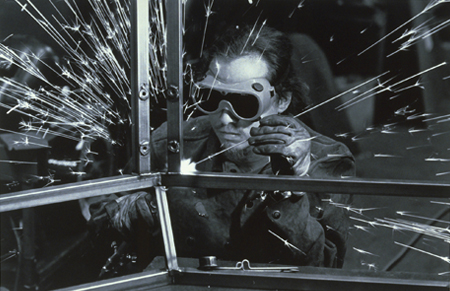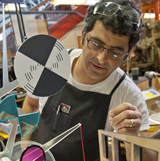Heart of the Exploratorium

The Water Drop Photography exhibit was in the museum workshop for repairs. Anyone visiting the Exploratorium could peer into the busy shop and see it on exhibit developer Erik Thogersen’s table. Climbing the stairs from the main floor to the Mezzanine, visitors could get an even better look: There was the camera and the flash, bristling with multicolored wires, mounted in a plywood box, and rigged to snap a picture of water drops falling into a coffee mug.
A quick look at this exhibit—its evolution, its rough-edged aesthetic, and its very public refurbishment—provides an object lesson in how the Exploratorium differs from most other museums. Central to that difference is the shop, where exhibits are conceived, prototyped, reimagined, and refurbished—not just by exhibit developers, but also by the exhibit technicians who work closely with them, by visiting artists and scientists, as well as by teachers and their students.
Since its founding, the Exploratorium has been dedicated to pulling back the curtain on how things work. We build exhibits that help visitors discover the inner workings of the universe, and we want people to see how those exhibits are created. The museum’s shop—a productive commotion audible and visible to all—is the buzzing, flashing, sparking heart of those efforts. The shop at our new Pier 15 campus will both honor and extend that tradition, with 50% more space (7,724 versus 11,318 square feet) and some impressive new tools.
“We’re bringing some of our indestructible World War II surplus tools with us,” says Erik, “and supplementing them with very 21st century tools,” like a Computer Numeric Control (CNC) router and a powerful laser cutter. The latter, says Erik, “allows you to draw on the computer, then have the tool cut what you’ve drawn. Such tools open up the kinds of people who can create exhibits.”
In the new shop, adds exhibit developer Denise King, “staff will be seated within project spaces to help support a more collaborative work place: when the staff move around on projects, their spaces move with them. We’re hoping this will help projects gel more quickly, make it easier to incorporate visiting scientists and artists, and serve as impromptu meeting spaces to discuss exhibit prototypes.” Prototypes like the Water Drop Photography exhibit, for example.
Erik, who created the exhibit, explains that he got the idea from photos of splashing water, in which the photographer hand-timed the shutter release, only rarely capturing the exact moment intended. Erik created an exhibit that allows visitors to choose the delay (measured in milliseconds) after the drop is released and before the camera snaps a picture. Visitors see the captured image on a video monitor and adjust the delay until the photos they’re taking are capturing the exact moment they want.
But the real twist in the exhibit’s development came, says Erik, when he demonstrated the prototype at one of the museum’s After Dark evenings. “These are awesome pictures,” someone said, “but I think they’re canned. It pretends to take a picture and then shows one of the canned shots.” To prove otherwise, Erik removed the exhibit’s cover and stuck his hand in; the next photo showed his hand, proving that the photos weren’t canned. “And when we saw the photo of the drop coming down, with my hand in the background, the water drop had acted like a lens, imaging my hand upside down.”
That accidental affect became a central element of the reimagined exhibit. “We cut a hole in the side of the exhibit, and you can put you face there and see how the water drop distorts the image of your face. If four drops come off the splash, each shows your face upside down.”
Erik says visitor feedback, solicited both by the Visitor Research and Evaluation team and by developers themselves, is key to revising and enhancing exhibits. “I’d been struggling with how to make the water-drop exhibit more interactive,” he says. “When I put my hand in to prove my point it was like, ‘My God, that is totally what people should do.’”
At the museum’s new campus, exhibit developers will have even more room to work on exhibits, and visitors will have a chance to engage at ever-deeper levels. Adjacent to the shop will be the Tinkering Studio, where “visitors themselves can create exhibit-like stuff,” says Erik. “Having the Tinkering Studio near the shop will hopefully blur the line between finished exhibits, prototypes, and things visitors can directly participate in.”
